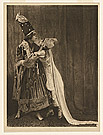Thamar
Choreographic drama in one act
- Producer: Les Ballets Russes de Serge Diaghilev
- Premiere: 20 May 1912, Théâtre du Châtelet, Paris
- Costume design: Léon Bakst
- Costumier: Marie Muelle
- Scenery design: Léon Bakst
- Music: Mily Alexeyevich Balakirev, 1882
- Choreography: Michel Fokine
- Libretto: Léon Bakst, after a poem by Mikhail Lermontov
- Main characters: Thamar, Queen of Georgia, the Prince, ladies-in-waiting,
guards, servants
Set in the castle of Queen Thamar of Georgia, the ballet opens with a scene of daily activity in the court. One of the Queen’s ladies-in-waiting notices the approach of a stranger, a prince, through the window. Gesturing with a wave of her blood-red scarf, Thamar indicates that he should be admitted. Following his presentation, Thamar entices him with a series of dances before they retire for lovemaking. When they re-enter, Thamar stabs the unsuspecting prince in the heart and pushes him out through a trapdoor into the flooded river below. Retiring to her couch once more, she invites the arrival of yet another victim with a wave of her scarf.
The subject of the life of Thamar, Queen of Georgia from 1184 to 1213, was transformed in the spirit of nineteenth-century Romanticism, becoming a symbol of nationalist pride in the face of growing Russian cultural dominance in the Caucasus. Russian poet Mikhail Lermontov fictionalised Thamar’s history within his interpretation of a Georgian legend of a malevolent seductress in his 1841 poem, Tamara. It was this version, along with Balakirev’s symphonic poem Tamara, that inspired Bakst and Fokine for the Ballets Russes production of Thamar in 1912. Bakst’s looming set dramatised Thamar’s isolated court in her castle in the treacherous Terek River and provided a stark background for his sumptuous and richly detailed costumes for the queen, her courtiers, guards and suitors.
The men’s costumes are based on the traditional Caucasian cherkeska (Circassian coat) or kaftan with beshmet underdress. They show the traditional small leather pockets (gazyrnitzas) for wooden rifle-cartridge tubes sewn in decorative patterns on the chest. The women’s costumes are based on the nineteenth-century versions of the traditional southern Russian poneva ensembles, with their geometrical and rhomboidal ornamentation of braids and metallic appliqués. Thamar’s costume includes the cerise silk scarf with which she lured her hapless suitors.






